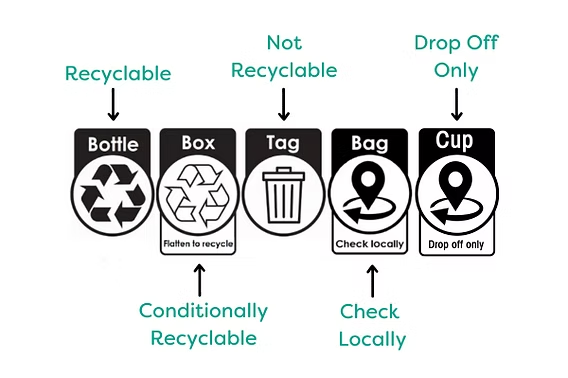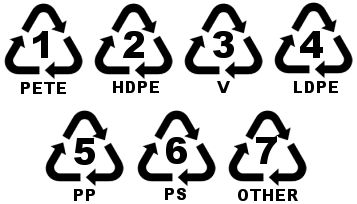This year, National Recycling Week is taking place from November 10 – 16, and it’s the perfect time to rethink the importance of recycling and how we manage our waste. While Australians are eager to recycle, many of us still make common recycling mistakes that can spoil the process, like tossing soft plastics into kerbside bins, leaving food scraps on recyclables, or assuming everything with a recycling symbol is good to go.
According to Cleanaway 2023 Recycling Behaviours Report, over a third of Australians (38%) still find recycling confusing, a rise of (9%) since 2022. Nearly half (44%) said they struggle to find clear recycling instructions, highlighting the ongoing confusion around waste disposal. Even more concerning, four in five Australians (81%) misidentified a common recycling symbol, underscoring the need for clearer communication and better education to improve kerbside recycling practices.
1. The Soft Plastics Problem

One of the biggest recycling mistakes in Australia is the inclusion of soft plastics in kerbside recycling bins. Items like plastic bags, bread bags, frozen veggie pouches, chip packets, and cling wrap often find their way into the yellow bin. Unfortunately, these materials can’t be processed by most kerbside recycling systems and end up causing machinery blockages at sorting facilities.
According to Cleanaway, 2023 Recycling Behaviours Report, 32% of people are still incorrectly placing soft plastics into their recycling bins.
The collapse of the REDcycle program in 2022, which previously collected soft plastics at major supermarkets, has further complicated matters. Without convenient recycling options for soft plastics, many consumers remain confused about what to do with them. Most councils recommend disposing of these items in general waste (Red Bin) until new soft-plastic recycling programs are rolled out nationwide. Some community initiatives, councils, and specialised centres also accept soft plastics, check with your local council or participating supermarkets for approved drop-off points. Understanding the differences between plastic types and how they’re processed in Australia can help reduce confusion and improve recycling habits overall. The plastics recycling process is far more complex than you may think, so before you make your next purchase, you might want to make sure you’re across some of the basics.
2. Misunderstanding Recycling Symbols

Another big source of confusion is the recycling symbol itself. Many Australians assume the familiar Mobius loop (the triangle of chasing arrows) means an item is fully recyclable. The Cleanaway Recycling Behaviours Report (2023) found that 82% of Australians believe the Mobius loop guarantees recyclability, leading to misplaced items like soft plastics, multilayer packaging, and composites in recycling bins.
To clear things up, the Australasian Recycling Label (ARL) was launched in 2018. It provides simple, consistent instructions on how to correctly dispose of each part of a product’s packaging, whether it belongs in kerbside recycling, landfill, or a special drop-off point. But many people still don’t recognise the ARL, showing that we’ve got work to do when it comes to better recycling education and clearer packaging communication.
Here’s what the five ARL symbols mean:
Recyclable in kerbside recycling: The solid recycling symbol means it can go straight into your yellow-lid recycling bin.
Conditionally recyclable in kerbside recycling: The clear recycling symbol means it’s recyclable only if you follow the instructions. If not, it should go in the rubbish bin (Red Bin) to avoid contamination.
Drop Off Only: Must be taken to a designated collection point.
Check Locally: Recycling options may vary depending on your council.
Not Recyclable : The bin symbol means it belongs in your red-lid general waste bin because it can’t be recycled and would contaminate the recycling stream.
3. Believing All Plastics Are Recyclable

Recycling can be confusing, particularly when it comes to plastics labelled with numbers 1 to 7 inside the recycling symbol. These numbers identify the type of plastic and indicate whether it can be recycled through kerbside collections or needs special programs. Understanding these distinctions is crucial to ensure plastics are disposed of correctly and actually make it into the recycling stream, while also encouraging Australians to reduce, reuse, recycle wherever possible to minimise waste and protect the environment.
#1 PET (Polyethylene Terephthalate): Common, clear, and lightweight, found in soft drink, juice, peanut butter, mayonnaise jars and vegetable oil bottles. These can usually be recycled through kerbside bins once emptied and cleaned out.
#2 HDPE (High-Density Polyethylene): Found in milk bottles, cleaning products like detergents or harsh chemicals, food tubs, and shampoo bottles. A 2018 study by ESE World B.V. found that clean HDPE can be recycled up to 10 times, so always rinse recyclables and follow your local council’s rules on lids, as requirements can vary.
#3 PVC (Polyvinyl Chloride): Used in toys, piping, furniture, medical equipment, cables, yard signs, and some food packaging. Difficult to recycle in kerbside recycling, so check with your local council or waste transfer station.
#4 LDPE (Low-Density Polyethylene): This includes soft, flexible plastics like produce bags, bin liners, bubble wrap, Ziploc bags, bread bags, and dry-cleaning bags. LDPE plastics are thin and flimsy, making them highly suitable for single-use applications.
LDPE isn’t accepted in kerbside recycling since it’s hard to sort and recycle properly. To address this, many Australian states have banned single-use grocery bags and introduced soft plastic recycling programs, with convenient drop-off points at major supermarkets.
#5 PP (Polypropylene): These are hard, lightweight, yet flexible plastics found in items like ice cream containers, takeaway boxes, some yogurt tubs, and syrup bottles. When clean, they can usually go into your kerbside recycling. Polypropylene is also considered safe for repeated use, as it’s unlikely to leach chemicals or break down over time.
#6 – PS (Polystyrene): This includes lightweight but bulky plastics like disposable cups, plates, foam packaging, and meat trays. Polystyrene is hard to recycle and usually isn’t accepted in kerbside collections as it can break into small pieces that harm wildlife and the environment.
#7 Other plastics: This category covers miscellaneous plastics like acrylic, nylon, rope, sunglasses, baby bottles, water cooler jugs, and CDs. Because #7 includes many different types such as polycarbonates, polyamides, and polyurethanes, these plastics are almost never recycled.
Bioplastics, like Poly Lactic Acid (PLA), also fall into this group. Made from natural materials such as corn starch or sugarcane, PLA is designed to break down in commercial composting facilities, not in kerbside recycling or landfills.
4. Recycling Dirty or Food-Contaminated Items

Containers, boxes, or cartons that still have grease, sauce, or food residue can ruin entire batches of recyclables during sorting. Cardboard, for example, is generally very recyclable, but items like greasy pizza boxes or takeaway containers can contaminate otherwise clean paper and cardboard, potentially causing the whole load to be rejected. To prevent this, only clean or lightly used cardboard should be placed in the recycling bin, while heavily soiled or food-stained items must go in general waste.
By keeping recyclables clean and free of food residue, we can significantly increase the chances that materials are successfully remanufactured rather than being sent to landfill.
Research by Planet Ark reveals that 58% of Australians fail to remove food residue before recycling, and bin audits in some regions found up to 25% of kerbside recyclables rejected due to contamination. As Planet Ark advises: “If it’s too dirty to reuse, it’s too dirty to recycle.” Clean recyclables are far more likely to be successfully remanufactured rather than sent to landfill.
Despite clear labelling and education campaigns, contamination in waste bins remains a major challenge. When food scraps, plastic bags, or dirty containers are placed in recycling bins alongside clean bottles and cans, they can spoil the entire recycling stream, sending valuable resources straight to landfill. Understanding the reasons and behaviours behind contamination, such as confusion over recycling guidelines or lack of convenient disposal options, is crucial in developing targeted interventions.
5. “Wish Cycling”: Hoping for the Best

Have you ever tossed something into the recycling bin, hoping it could be recycled, only to wonder later if it really belonged there? You’re not alone, this common habit is known as wish cycling, and while it comes from good intentions, it can actually do more harm than good.
In Australia, many people mistakenly recycle items like takeaway coffee cups, soft plastics, compostable packaging, ceramics, and even toys, believing they’ll be processed correctly. According to Cleanaway 2023 Recycling Behaviours Report, 62% of Australians incorrectly put takeaway coffee cups in recycling bins, despite most being non-recyclable due to their plastic linings.
Wish Cycling contaminates recycling streams, drives up processing costs, damages sorting equipment, and lowers the value of recyclable materials. By learning the essential recycling facts, what can and can’t be recycled and choosing reusable alternatives where possible, we can all help make recycling more efficient and effective for everyone.
6. Bagging Recyclables in Plastic Bags

Even in 2025, one simple mistake continues to hold back Australia’s recycling efforts, which is bagging recyclables. Many people still believe that placing bottles, cans, and paper into a plastic bag before tossing them in the recycling bin is the right thing to do. In reality, it causes more harm than good.
When recyclables are sealed inside plastic bags, sorting machines at recycling facilities can’t recognise or separate them properly. As a result, entire bags of recyclable materials are sent straight to landfill.
In Victoria, a 2021 survey by Sustainability Victoria (Recycling Victoria Campaign Baseline Research, July 2021) revealed that 16% of residents still put their recyclables in plastic bags.
The key takeaway is to always put your recyclables loose in the bin. If a liner is necessary, opt for paper or another recyclable material instead. This simple action helps recycling facilities run more efficiently, minimises contamination, and gives more materials a second chance instead of sending them to landfill.
7. E-Waste and Battery Disposal Errors

Each year, 10,000-12,000 battery-related fires occur across Australia, according to the Australian Council of Recycling (ACOR). Most are caused by lithium-ion batteries tossed in household rubbish or recycling, putting workers and the public at risk while driving up waste industry costs and insurance premiums.
Lithium batteries can explode or ignite when crushed, punctured, or overheated, triggering thermal runaway, a chain reaction that creates intense, toxic fires nearly impossible to extinguish. Often hidden in vapes, e-cigarettes, toothbrushes, and small electronics, they can ignite during collection or sorting. In NSW, Fire and Rescue responded to 275 battery fires in 2023, a 66% increase from 2022, with each incident costing recycling businesses up to $400,000.
Despite the risks, a 2023 Cleanaway report revealed that 24% of Australians still throw batteries in kerbside bins, 37% don’t use drop-off points, and 38% are unsure how to recycle phones or small devices.
When dumped in landfill, batteries leak toxic metals such as nickel, cadmium, and mercury into the environment. But when recycled correctly, up to 95% of their materials can be recovered and reused.
Dispose of household batteries (AA, AAA, C, D, 9V, button, and small rechargeables up to 5kg) at a B-Cycle drop-off point: www.bcycle.com.au. For larger batteries (phones, laptops, TVs), use Recycle Mate to find your nearest recycling location.
8. Throwing Tissues in the Recycling Bin

While tissues, toilet paper, and paper towels are made from paper, they are considered low-grade due to their short fibres, making them unsuitable for recycling. Unlike materials such as metal or glass, paper cannot be recycled indefinitely, each cycle shortens the fibres until they become too short to reuse effectively.
Instead of recycling, tissues, toilet paper, and kitchen towels can be composted or placed in a food waste collection service. If that’s not possible, they should go in the general waste bin. It’s important to note that used tissues or kitchen towels with food scraps are also not recyclable.
9. Confusing Compostable and Biodegradable Items

Many of us assume that items labelled “biodegradable” or “compostable” can be tossed into regular recycling or even landfill and will simply break down. In reality, most of these products don’t degrade as quickly as we might think, and placing them in the wrong bin can actually contaminate recycling and composting streams.
A study by Griffith University, Microplastic in Australian processed organics: Abundance, characteristics and potential transport to soil ecosystem, found that just one kilogram of compost could contain up to 16,000 microplastic particles, often originating from biodegradable packaging that failed to fully break down.
The Australian Packaging Covenant Organisation (APCO) also reveals that while 86% of plastic packaging is technically recyclable, only 19% is actually recycled. When compostable or biodegradable items end up in recycling or conventional composting systems, they can interfere with processing and reduce the quality of the final product.
To avoid this, don’t place these items in kerbside recycling bins. Instead, compost certified biodegradable products at home or take them to commercial composting facilities that are equipped to handle them. Following Australian certification standards and checking labels carefully can help ensure these items end up where they belong, keeping both recycling and composting systems cleaner and more efficient.
Recycling is one of the simplest ways to make a positive impact on the environment, but even small mistakes can undermine our efforts. By understanding common recycling errors like contaminating bins, misidentifying materials, or overestimating what can be recycled, we can ensure that more waste is properly processed and less ends up in landfill.
Recycling in Australia doesn’t have to be complicated. Simply following your local council’s guidelines, giving containers a quick rinse, and paying attention to recycling symbols can make a real difference. It’s the little things like flattening boxes, separating soft plastics, or disposing of batteries properly that add up over time.
When we take these small steps, recycling stops being just another chore and becomes a way to actively care for our environment.

